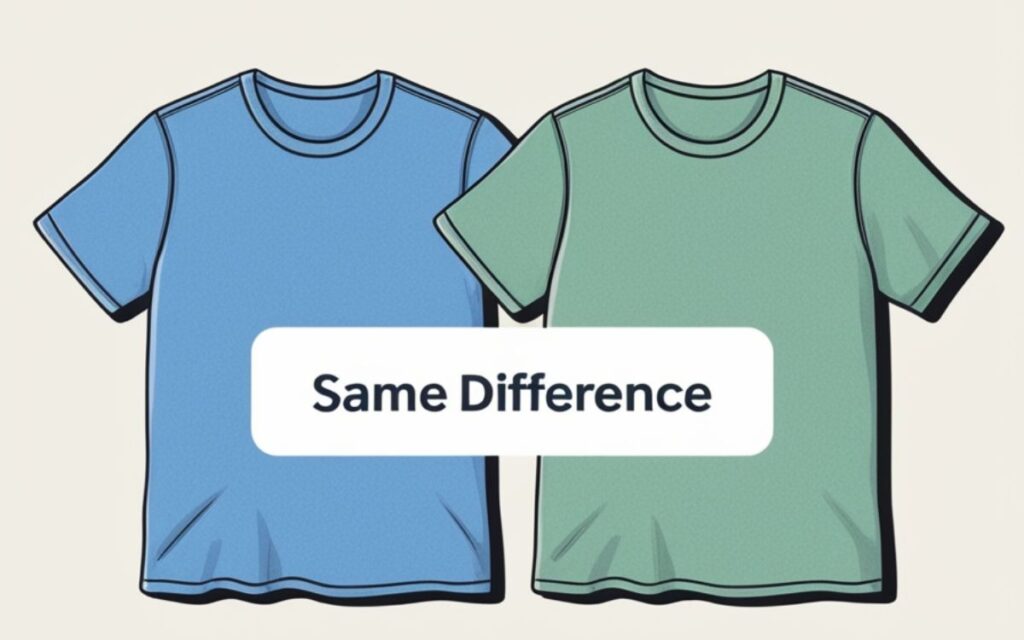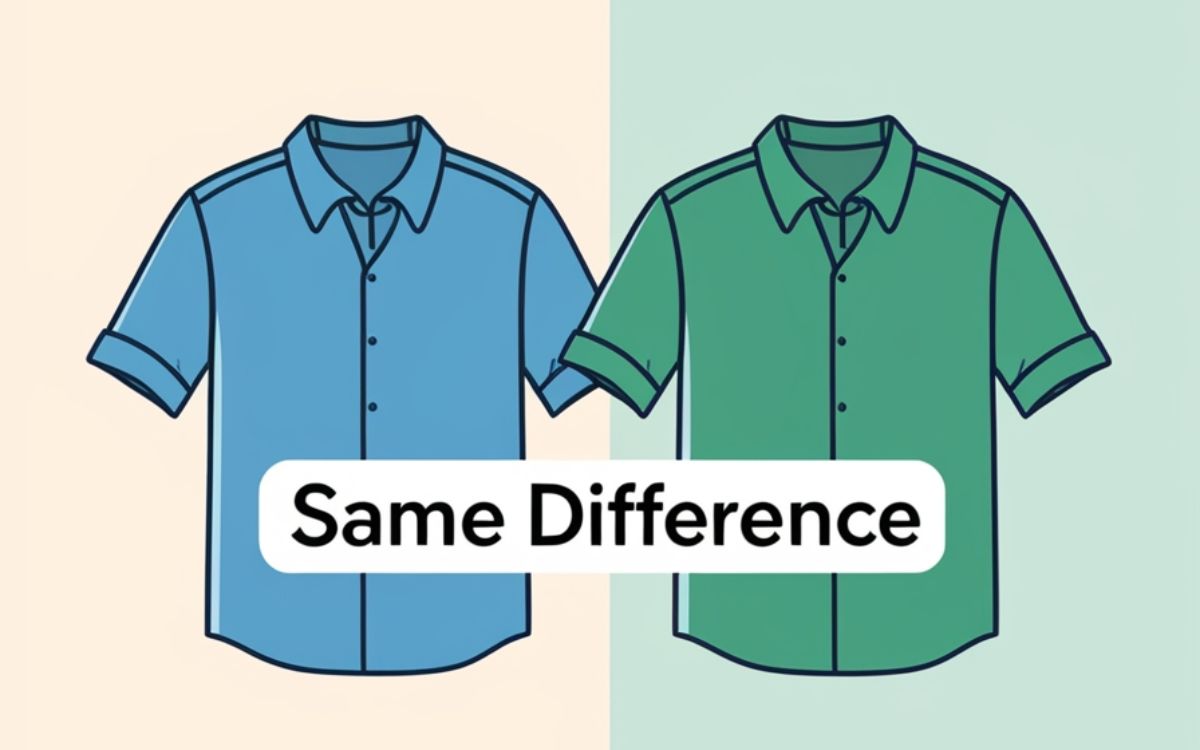Same Difference is an idiom used when two things are almost the same. People use it to show that small changes or details do not matter. It helps make everyday conversation short and easy to understand.
This expression often appears in casual talks. For example, people say it when two choices lead to the same result. It adds a playful touch and makes communication smooth without focusing on tiny differences.
In writing or speaking, using idioms like this can make sentences more interesting. It shows that minor differences are not important. The phrase works best in informal situations with friends or family, keeping talks friendly and simple.
What Does “Same Difference” Actually Mean?
Same Difference means that two things are very similar even if they look a little different. People use this expression to show that small changes or details do not really matter in daily life.
This idiom helps make conversations easy and quick. It shows that minor differences are not important. Using it in talks with friends or family makes speech smooth, friendly, and easy to understand.
- Same Difference shows that two things are almost the same, even if they look a little different.
- It means small differences do not matter in daily life.
- People use it to make conversations short and easy.
- The phrase adds a playful or casual touch to talks.
- It helps focus on the main idea instead of tiny details.
Why Use “Same Difference”?
- It saves time by ignoring tiny differences in choices or opinions.
- It shows agreement even when small details vary.
- The phrase adds humor or playfulness to conversations.
- It makes speech smooth and easy to follow.
- It helps focus on important ideas instead of minor points.
Tone and Context: How “Same Difference” Fits Into Conversation

The tone of this expression is usually casual and friendly. People use it in daily talks with friends, family, or classmates. It shows that small differences are not important and keeps the conversation light and easy to follow.
This idiom fits well in informal situations. It can add a little humor or make speech more relaxed. Using it helps listeners understand that minor details do not change the main idea, making communication simple and clear.
| Tone | Example Situation | Meaning Conveyed |
| Casual | Friends deciding on dinner options | Minor choices don’t matter |
| Sarcastic | Two people arguing about a small detail | Difference is insignificant |
| Humorous | Joking about alternative spellings or phrases | Lighthearted dismissal of differences |
Real-Life Examples of “Same Difference” in Dialogue
In real-life examples, this idiom helps show that small differences do not matter. For instance, when two friends choose different colors for the same shirt, they can say it is the same and continue without arguing.
In conversations, people also use this expression to compare similar choices. For example, whether someone takes the bus or walks, the result is almost equal. Using it makes everyday talks smooth, friendly, and easy to understand.
- Alex: “I like the blue shirt.” Jamie: “Green works too—same difference.”
- Sara: “Is it called a couch or a sofa?” Mike: “Same difference—both mean the same.”
- Co-worker 1: “The meeting starts at 2 or 2:15.” Co-worker 2: “Same difference—we’ll start around then.”
- Friend 1: “Take the bus or walk?” Friend 2: “Same difference—we arrive at the same time.”
- Student 1: “Spell it ‘tomato’ or ‘tomahto’?” Student 2: “Same difference—both are fine.”
See also : One Fell Swoop: Meaning, Origin & Modern Usage
Origin and Historical Roots of “Same Difference”
The origin of this idiom comes from American English. People started using it in the mid-1900s. It combines two opposite words to show that small differences do not really change the meaning, making speech simple and playful.
Its historical roots appear in movies, books, and everyday talks. The expression became popular because it is short, easy to remember, and helps people explain that minor changes do not matter in daily life.
Key Historical Facts:
- The idiom appeared in American English during the mid-20th century.
- It became popular through movies, TV shows, and books.
- The phrase is an oxymoron, joining opposite words for effect.
- People used it in everyday speech to explain small differences quickly.
- Its popularity grew because it is short, memorable, and playful.
Linguistic Evolution: Why Did “Same Difference” Stick?
The linguistic evolution of this expression shows how it became popular over time. People liked its short and catchy style. It stayed in language because it quickly explains that small differences do not really matter in conversations.
This idiom remained common in speech because it is easy to say and understand. Its fun and playful nature helps speakers add humor and clarity, making everyday talks simple, friendly, and easy to remember for everyone.
Factors Behind Its Popularity:
- It is short and easy to say and remember.
- The idiom clearly shows that small differences do not matter.
- It adds a playful or humorous touch to conversations.
- People can use it in many casual situations.
- Media like TV shows and movies helped make it widely known.
Similar Idioms & Their Nuances
There are many similar idioms that show two things are almost the same. Expressions like “six of one, half a dozen of the other” or “potato, potahto” help people explain small differences in a simple and playful way.
Each expression has a slightly different tone. Some sound funny, while others feel calm. Using these idioms in daily talks makes conversations clear and friendly, helping listeners understand that tiny differences do not change the main meaning.
| Idiom | Meaning | Tone | Usage Context |
| Same difference | No meaningful difference | Casual, informal | Everyday conversation |
| Six of one, half a dozen of the other | Equal or no real difference | Neutral, informal | Comparisons |
| Potato, potahto | Different ways to say the same thing | Playful, humorous | Light debates |
| It’s all the same | No difference, indifferent tone | Slightly formal | Broader discussions |
Regional and Cultural Usage Variations

The regional usage of this idiom varies in different countries. It is common in the United States, while people in the United Kingdom or Australia may use other expressions to show that small differences do not matter.
Cultural habits affect how people speak. Some expressions are popular with younger speakers, while older people use them less. Using these phrases in talks makes everyday communication easy, friendly, and clear across casual settings.
Usage Insights:
- The idiom is common in casual talks in the United States.
- People in the United Kingdom or Australia use it less often.
- Younger speakers use it more in text messages and chats.
- It works best in friendly, informal situations with family or friends.
- Using it helps make everyday conversations smooth, clear, and simple.
Cultural Perception
- Younger people find the idiom fun and easy to use.
- Older speakers may see it as too informal for serious talks.
- It adds a playful touch to casual conversations.
- The phrase shows that small differences do not change the main idea.
- Using it makes everyday communication friendly and lighthearted.
Grammar & Phrase Structure: Why “Same Difference” Works
The grammar of this expression is unique because it joins two opposite words. Even though it seems unusual, it works well in English. People understand the meaning from how it is used, not from literal rules.
The phrase structure makes the idiom short and easy to remember. Its punchy style helps speakers explain that small differences do not matter. Using it in conversations keeps everyday talks simple, clear, and friendly.
See also : Dieing vs Dying: Simple Guide to the Right Spelling
How it functions:
- The idiom works by combining two opposite words to make a clear meaning.
- It explains that small differences do not matter in daily situations.
- People use it to make speech short and easy.
- The phrase adds a playful or casual tone to talks.
- It helps speakers keep everyday conversations smooth and friendly.
Alternative phrases for formal use:
| Informal Idiom | Formal Equivalent |
| Same difference | No significant difference |
| Six of one, half a dozen | Equally acceptable options |
| It’s all the same | No material difference exists |
Summary & Key Takeaways About “Same Difference”
The key takeaway is that this idiom shows small differences do not matter. It is short, easy to say, and adds a playful touch. People use it in casual talks to keep everyday conversations smooth and friendly.
It works best in informal situations with friends or family. This expression helps speakers explain that minor changes do not change the main idea. Using it makes communication simple, clear, and easy to understand for everyone.
What to remember:
- The idiom shows that small differences do not matter.
- It is best used in casual conversations with friends or family.
- The phrase adds a playful or friendly touch to talks.
- Avoid using it in formal writing or serious discussions.
- Using it helps make everyday communication clear, simple, and smooth.
Bonus: Quick Reference Chart for “Same Difference” Usage
| Situation | Use “Same Difference”? | Reason |
| Casual conversation | Yes | Fits informal tone perfectly |
| Business emails | No | Too informal and ambiguous |
| Academic writing | No | Lacks precision |
| Text messages | Yes | Common and understood |
| Formal speeches | No | Too casual and potentially unclear |
Case Study: “Same Difference” in Popular Media
- The idiom appears in TV shows like Friends to show small differences don’t matter.
- In The Simpsons, it is used to make jokes about minor arguments.
- Media examples help people learn and remember the phrase easily.
- Using it in shows made the expression popular in everyday talks.
- It shows how idioms can enter common language through movies and TV.
Final Thoughts
In final thoughts, this expression helps people show that small differences are not important. It makes talks short and friendly. Using it in casual conversations adds a playful touch while keeping everyday communication clear and easy to follow.
This idiom works well with friends, family, and classmates. It helps speakers explain ideas quickly without focusing on tiny details. Using such expressions makes conversations simple, smooth, and pleasant for everyone in informal situations.
FAQS:
What is the meaning of same difference?
Same difference means two things are essentially the same, even if they look different. It shows minor differences do not matter in everyday situations.
Is saying “same difference” grammatically correct?
Yes, it is grammatically acceptable as an idiomatic expression. Its meaning comes from usage rather than literal grammar rules, making it clear in casual speech.
Is “same difference” an oxymoron?
Yes, it is an oxymoron because it combines opposite words. This creates a playful effect, showing that small differences do not change the overall meaning.
How do you say “same” in different?
You can express same using phrases like “no real difference,” “identical,” or “equal,” depending on context, while highlighting that minor variations are unimportant.

Join Bibcia on a journey to master English grammar. Discover easy lessons, writing tips, and practical examples designed to make learning grammar simple and effective.










